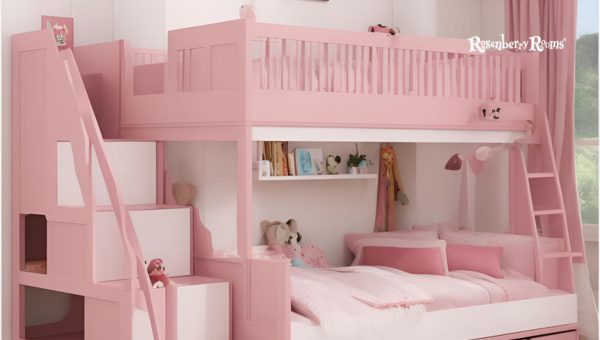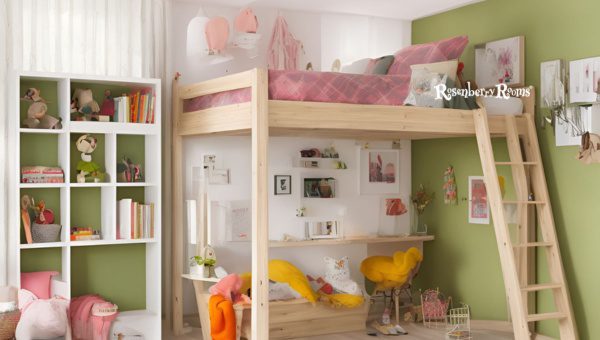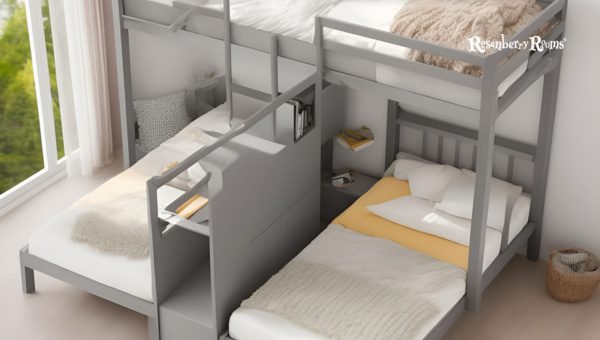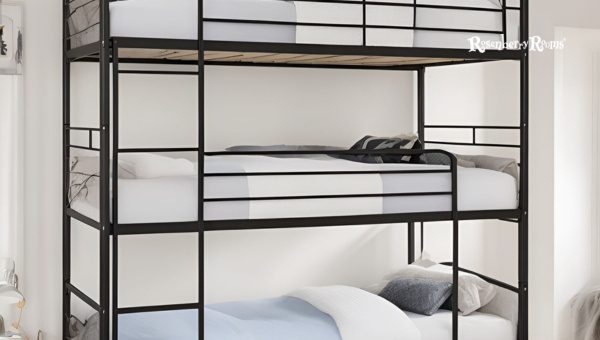Choosing the right bunk bed for your space, whether for your kiddos, a dorm room, or even a guest room, can be tricky. Not only do you need to ensure the bed is safe and sturdy, but the size of a bunk bed must fit perfectly into your space while providing enough comfort to ensure a good night’s sleep.
Of course, the widely varying designs and styles available on the market don’t simplify this choice! The key is getting accurate measurements and understanding what will work best in the allocated space regarding height, width, and length.
So picture this: you’ve just found a spot in your home for that new bunk bed you’ve always wanted. Maybe you’re revamping your kids’ room or finally finding a solution to accommodate guests during holidays and sleepovers.
Now comes the big question – what size should that bunk bed be? Hold that thought right there! Before you rush off to buy—you know what—let’s talk about how to nail down that decision with utmost precision.
Contents
Bunk beds typically have a standard size. The width is usually around 39 inches (99 cm), the height is approximately 65 inches (165cm), and the length is around 79 inches (200 cm).
This size may vary slightly depending on the design and manufacturer; therefore, always check the dimensions before purchasing to ensure it fits your space correctly.

Regarding the perfect bunk bed for your space, size matters. Understanding the different sizes can help you make a more informed choice, whether you’re scouting for beds for your twins, setting up a dorm room, or looking to optimize limited space in a small apartment.
Bunk bed sizes differ with each category meant for specific usages and spaces. Here, we’ll explore several categories including Twin, Twin XL, Full (or Double), Double XL, and Queen size bunk beds.
The smallest size option is the twin bunk bed. Measuring 75” in length, 38” in width, and 8” in depth, – this type of bunk bed is an ideal choice if you work with relatively constrained spaces.
Particularly popular for children’s rooms or shared apartments due to their compact nature, they can accommodate standard twin-size mattresses comfortably while leaving ample room to move around them.
Looking for slightly more legroom than a standard twin? The Twin XL bunk bed might be your best bet! With mattress measurements that read 80” x 38” x 8”, the additional five inches, compared to the standard twin, provides extra length, particularly suited for taller kids, teens, and adults.
A Full or Double bunk bed accommodates larger mattresses of dimensions 75” L x 53” W x 8” D. This means more comfort due to increased width as compared to a twin or twin XL size but remains at par when it comes to length with that of a typical twin bed.
This feature makes it perfect if two children share a bunk or if adults need to use them instead of traditional beds.
Want all the width of a full bunk but craving more length? The Double XL it is. At dimensions of 80” L x 53” W x 8” D, this bunk bed size is custom-built for users who enjoy a plentiful space in terms of width and length. It accommodates smaller adults or those who love to stretch out when they sleep.
The Queen-sized bunk bed reigns supreme when it comes to size! Boasting mattress dimensions of 80” L x 60” W x 8” D, these beds are designed to provide maximum sleeping room.
Perfect for older teenagers, adults, or guest bedrooms where couples might be staying—this type provides expansive sleeping spaces on both levels.
Read More: Best Age For Bunk Bed [5 Important Things To Know]
Choosing the right bunk bed size becomes much easier once you know what you need. Remember, what had worked perfectly for your friend may not do the same magic in your space!
It’s all about optimizing what you have and where you wish to place your stunning bunk bed. Let’s delve deeper into key points guiding you through this decision-making process.
Having these factors nailed down can simplify your decision massively, leading you to a bunk bed that perfectly fits your room and needs.

Choosing the right bunk bed is more than measuring the dimensions of your room and selecting a mattress size.
Another significant aspect is the style or type of bunk bed that best complements your needs and interior décor. Your choice will depend on design preference, functionality, number of sleepers, space considerations, and budget.
Bunk beds are typically made from three main materials: wood, metal, or plastic.
Each has its strengths. Wooden frames are durable and robust with diverse designs, while metal frames are lightweight yet sturdy with sleek modern aesthetics. On the other hand, plastic frames have a playful vibe ideal for children’s rooms.
Every one of these options varies in terms of style, flexibility, functionality, and even price. Plus, many come with add-ons like ladders or stairs, guard rails, drawers, or under-bed storage—each adding value by enhancing safety or providing additional convenience.
Also Read: 19 Best Places To Buy Kids Furniture Online In 2024 [Trustworthy Stores]
Choosing a bunk bed is only half the journey. Once it’s set up in your home and sturdy enough to have monkey-like children clambering over it, you’ll quickly realize that bunk beds aren’t just sleep corners – they’re imaginative spaces for kids, efficient placeholders for guests, and pretty nifty hangout spots. Let’s explore how you can rock these awesome dual-level frames in different areas of the house.
In homes with a premium space, the lower section of a bunk bed can be an absolute lifesaver! It’s not just another space to rest your head; it can also double as your favorite hangout spot.
If you’ve opted for a full or queen-size lower bunk, throw comfy pillows and soft throws on it. Maybe add a portable side table to hold snacks and drinks while watching late-night television or playing video games.
With flexibility in design, many contemporary bunk beds offer options to fold up the bottom bed into a comfortable sofa during the day. This means this corner remains functional even when it isn’t bedtime!
Imagine curling up with your favorite book on that plush sofa bunk under layers and warm blankets! In essence, creatively using your bunk bed can transform every lazy Sunday into an indoor vacation right at home.
How often does Aunt Patty randomly show up at Thanksgiving with her trove of questionable casseroles? For many homeowners who frequently host guests but don’t have extra bedrooms to spare – placing a stylish bunk bed in one corner of your guest room can do wonders!
A well-made, sturdy wooden or metal frame with plush bedding on each level offers multiple sleeping options without consuming much space—ensuring everyone gets their beauty sleep even if the house is bustling with out-of-towners. Opt for larger sizes like Queen or Double XL if kids and adults may be occupying these spaces.
If you’ve ever stayed in a dormitory, you know that space is premium. With limited square footage, every inch counts. This is where bunk beds are a game-changer! Bunk beds allow college students to maximize their constrained spaces efficiently.
Stacking beds vertically creates more floor room for other essentials like desks, wardrobes, and chill-out spots.
Staring at standard dorm room dimensions, typically 12′ x 18′, twin or twin XL bunk beds are popular choices; they provide ample rest while leaving much-needed space for studying and recreation.
Also Read: How To Loft A Dorm Bed In 2023? [5 Simple Ways]
Bunk beds and vacation homes are a match made in heaven! Cozy cabins, lakeside lodges, or beach houses with limited bedroom spaces but the need to accommodate larger families or groups have found an answer in bunk beds.
They allow maximum sleeping capacity with the least spatial requirement. Styles like rustic wooden bunk beds fit beautifully into cabin aesthetics while robust enough for seasonal demands.
Choosing the correct size – Double XL or Queen – can make it more comfortable for adults and kids, enhancing those holiday vibes.
The magic of bunk beds truly shines in a kid’s room! Beyond being space-savers – providing room for play areas and study desks – bunk beds also stimulate creativity among children.
Imagine it being a pirate ship one day, a castle on another – fostering imagination and playtime becomes much easier with them in your children’s room.
Kids getting their sleeping space fosters a sense of privacy and ownership, which aids in their personality development!
Opting for twin or full-sized bunks with safety railings would be ideal, considering the required safety-to-comfort ratio.

A bunk bed is more than just a dual-level sleeping arrangement. Beyond its apparent feature of providing more sleeping spaces in less square footage, it caters to numerous other benefits, making it an excellent choice for many living situations.
It’s a magical piece of furniture that supports better organization, offers multipurpose usage, and encourages bonding moments. Let’s delve deeper into what makes bunk beds a practical investment for your home.
Bunk beds infuse a unique aesthetic appeal to a room. They’re fun, cozy, and even nostalgic for adults who remember their childhood sleepovers or shared sibling spaces. Select wisely and enjoy the manifold advantages that bunk beds bring to the table!

The days of specialty furniture needing professional assembly are long gone. With the right tools, patience, and comprehensive instructions, you can easily set up your brand-new bunk bed in your desired space. Follow these steps to ensure a safe and satisfactory assembly.
Choosing where to place your bunk bed is the first and one of the most crucial steps. You should consider a location that allows easy accessibility and room to maneuver. Having at least 2 feet of space between the top bunk and the ceiling is recommended.
Also, using a ladder or stairs, you should ensure enough floor space for safe ascent and descent. Besides, placing the bed along a wall can provide extra safety for whoever sleeps on the top bunk.
Before starting the assembly, ensure you have all the necessary tools and hardware ready. Keeping a screwdriver (both flathead and Philips), wrenches, pliers, a measuring tape, and a level tool nearby is handy.
Most bunk beds have specific hardware like screws, bolts, dowels, and slats. This might seem hectic at first glance – yet having everything organized and close to hand will make your assembly process smooth.
Remember that every piece matters: missing even a single bolt can affect the stability of your entire bunk bed.
After you’ve got your tools ready, it’s time to dive into the assembly instructions provided by the manufacturer. Reading these thoroughly before starting can’t be stressed enough – they are designed to guide you through each step of the process, specifically for your type of bunk bed.
Pictures or diagrams will often accompany these instructions, offering visual aid, which can be very helpful in ensuring you’re on track.
Laying out all components (like frames, ladders, or safety rails) and hardware (screws or bolts) is an effective way to organize yourself before immersing into assembly work.
Doing this beforehand—ideally in an open space—gives you a good view of what goes where. It also allows for easy access to any component you’ll need at any point during assembly. Treat each piece with importance.
Each component has its role, from bearing weight to adding aesthetics or ensuring safety – so dealing carefully with them ensures an overall sturdy build for your bunk bed.
When dealing with a wall-mounted bunk bed, stability is paramount. You must securely attach the bed frame to the wall to ensure this.
Start by identifying your wall’s sturdy sections—look for studs using a stud finder. This will give you solid anchor points for your bunk bed. Once you’ve found these, align your bed frame correctly and mark where you plan to drive in the screws.
Drill pilot holes into these marks, position your bunk bed frame against them, and carefully screw it into place, ensuring it remains level.
Also Read: 15 Best Bed Riser Alternatives In 2024 [Tested By Experts]
Assembling a lower bunk requires careful attention as it forms a sleeping area and support for the upper bunk. Follow the given instructions meticulously.
Clear enough space in your room for assembly and lay down each part that comes with your kit: side rails, end rails, and slats are common components.
Secure one end rail to each of its respective side rails, typically using bolts or screws, and apply enough torque to guarantee firmness but avoid over-tightening, as this can cause damage.
Repeat this process with the other end rail, securing it similarly to its opposite side rail counterparts. Finish by laying down slats evenly across these erected frames.
Similar principles apply when building your upper frame. Following manufacturer instructions exactly is key in ensuring this structure’s integrity, which will ultimately bear some serious weight!
Begin the assembly process as we did for the bottom section: side rails linked firmly with their corresponding end pieces once again, be careful not over tighten bolts or screws here while connecting—this can cause unnecessary stress/strain, potentially leading to less stability later down the line if not appropriately addressed.
Safety is paramount when using a bunk bed. Top bunks can be a little risky, especially for younger children who may be prone to rolling or falling.
That’s where safety rails come into play. Usually provided as part of your bunk bed kit, these bars you secure on all sides of the top bunk, acting as protective barricades. To install, you’ll use screws or bolts to fasten them firmly around the perimeter of the upper bed.
Ensure these rails extend at least five inches above the mattress to prompt protection against accidental falls and add peace to your night’s sleep, knowing everyone is safe.
Reaching that top bunk needs some climbing assistance! This is where a ladder becomes essential. Depending upon your bunk bed design, ladders can either be integrated into one side of the frame or detached, allowing for moving and positioning as required. Your task is simple – secure it carefully.
If detachable, hook it onto the required side at an easy angle enabling effortless access up and down, screwing if needed for extra stability. Integrated ladders need screws tightened enough to hold a person’s weight without wobbling.
This might seem obvious, but it’s often overlooked during assembly: ensure that every single screw and bolt are tightened securely – in every step of building your bunk bed! Loose hardware will lead to an unsteady structure, which may be dangerous.
So, take your time here, possibly using a drill instead of a manual screwdriver for optimum leverage and security. If the kit provides lock washers or other locking hardware, indubitably use it.
Check back periodically because, over time, screws can loosen with movement or weight shifts. Therefore, regular tightening checks ensure long-term stability and safety.
Alright, this is where the comfort factor comes in. You’ve set up the bunk bed frame; now it’s time to place your mattresses.
These should slide smoothly onto both levels of your bunk bed frame. Take note of any instances where it might bunch up or doesn’t quite fit – adjustments may be needed if this happens. The mattress should snugly fit within the rim of the frame.
Ensure there is no gap between the edges of the mattress and bunk bed frame, as this could present a safety hazard for users, especially children.
Safety first! Now that your mattresses are installed don’t skip checking for stability. Give your bunk bed a gentle shake and see any movement or wobbling.
Any motion could indicate that not all parts are secured properly, and you’ll need to go back and tighten things up.
Check if all safety rails are intact and securely fastened to prevent accidental falls while asleep, particularly on that upper bunk. Look for sharp edges or corners on both frames and ladders; you wouldn’t want anyone hurt during use.
Ladders are integral to any bunk bed ensemble—they serve as bridges to those coveted top bunks! It’s crucial to test them out by placing weight gradually onto each step before full-blown use to ensure they can bear both children’s and adults’ weight safely.
Haul yourself up slowly, testing each rung as you do so. If you notice any creaking sounds or bending in response to your weight pressure, this might mean more adjustments or replacements are needed before it’s ready for daily use.
Crafting a comfortable and personalized bunk bed space makes it feel like home. Start with the bedding – engage with your children’s input in choosing colors, patterns, or themes that resonate with them.
A ‘Fairy Tale’ themed bedding might become a big hit for your little princess-loving kiddo, or a ‘Space Expedition’ design for your future astronaut! To personalize further, curtains sustained by tension rods can be added to create a sense of private quarters.
Hang wall art or posters relevant to their interest on the side of their bunk to reaffirm ownership. Let’s not forget about fairy lights! Arranged prudently, these can add an enchanting ambiance while illuminating the space safely.
Bunk beds are fun, but they also demand responsibility due to the inherent risks with height and climbing involved.
As parents, you must educate your kids about safety rules: No jumping from bunks; always use the ladder to climb up or down; no pushing or rough-housing on the upper bed; always hold onto the guardrails while climbing – these are just a few tips you should emphasize.
According to American Academy of Pediatrics guidelines, children under six should not sleep in the top bunk. Education aids prevention; hence, devote time to discussing safety measures seriously with your little ones.
Explore More: What Is A Sleigh Bed? [cy] [Different Types And Pros & Cons]
Generally, you’ll want at least two feet of space between the top bunk and the ceiling to prevent injuries.
Yes, larger-sized bunks like Queen or Double XL are spacious for most adults.
Usually not, as most bunk beds are designed to accommodate specific mattress sizes. Always double-check dimensions before purchase.
Yes, weight limits depend upon the material and construction of the bunk bed; ensure to check this before buying.
Indeed! Many companies offer bespoke sizes; however, they may come with increased costs and longer delivery times.
Knowing the right dimensions for a bunk bed is essential in maximizing the effectiveness of your space. With options ranging from Twin to Queen size, it’s important to figure out what works best for your needs, considering factors like room size, the age and stature of the intended occupants, and future usability.
Making an informed choice will result in purchasing and investing in comfort and efficient space utilization.
We hope this guide has armed you with all the information you need to navigate the world of bunk beds confidently.